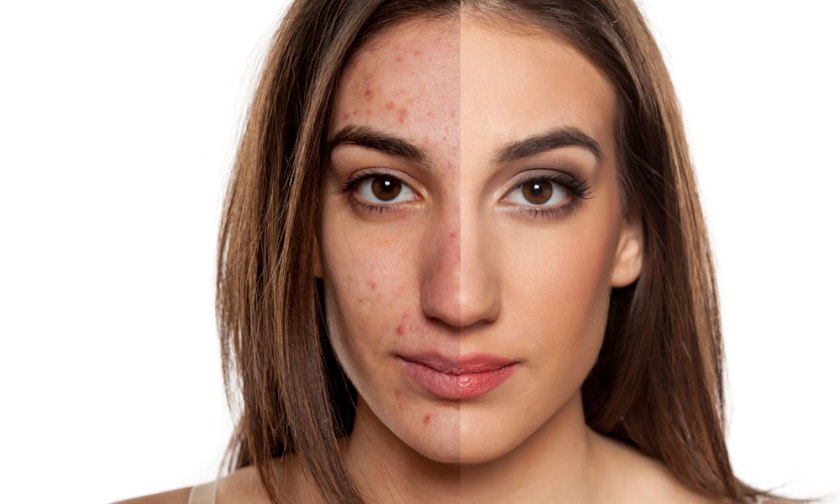For more than a year we have written extensively here at SPA+CLINIC about the wellness juggernaut of fine-tuning inner health to achieve outer beauty, particularly with regard to optimum skin condition.
But if, while getting to the guts of good skin, your clients are effectively sandblasting it on the surface, it rather defeats the purpose!
Incredible breakthroughs in skincare and device technology over the past 20-something years have allowed what man- and womankind once only dreamed of – turning back the clock on our appearance and resolving previously irrevocable skin conditions. But it has come at a price.
Consumers are bombarded daily with information about cutting edge skincare and all the ways it can dramatically improve the skin, and the wonders of device technology to banish everything from lines, wrinkles and pigmentation to acne and scars.
They hear voices everywhere telling them what to buy and why – glossy big-budget marketing campaigns featuring celebrities, influential bloggers and vloggers (some of whom have vested interests in the products they are lauding), magazine beauty editors, salespeople at department stores and chemists.
What to choose?! This plethora of choice becomes confusing, even overwhelming, when people are not being given proper professional guidance.
It means too many people are self-diagnosing, or getting the wrong advice from untrained spruikers or inexperienced therapists. They are using the wrong products, the wrong combination of products or too many products for their skin type = “skinflammation”.
Similarly, skin inflammation can occur when device technology is operated by someone who doesn’t truly understand its pros and cons and whether it is suitable for the client/skin concern they are treating.
Skinflammation has become an epidemic and manifests in many forms: from weakened skin that becomes prone to lines, wrinkles and pigmentation, to acne, rosacea, eczema and dermatitis, persistent redness and highly sensitised, inflamed skin that can’t tolerate anything on it.
For instance, age spots and other brown patches, primarily hormonally-driven melasma (one of the most difficult forms of pigmentation to treat; it can be managed but rarely cured) or post-inflammatory hyperpigmentation are the result of chronic inflammation of the melanocyte (pigment-producing cells), caused and/or aggravated by over-exposure to UV rays.
But the tide is turning as consumers become more and more aware of protecting what lies beneath the skin’s surface by protecting that surface. And dermal therapists are concurrently reclaiming their turf. After all they – YOU! – are the experts.
HOW INFLAMMATION AGES US FASTER
“The inflammatory response stresses the skin’s natural repair process, damages its protective barrier and breaks down collagen, hastening the appearance of lines and wrinkles and, ironically, undermining the very function of anti-ageing skin care – to slow ageing of the skin,” says Ralph Hebert, co-founder of Luzern Laboratories.
Luzern skincare is at the forefront of clean beauty innovations with pure, cold processed formulas using high efficacy actives from the pristine Valais region of Switzerland.
“One of the primary reasons Luzern products get such excellent results is the effort we take to eliminate the chemicals and toxins that cause inflammation and irritation.
“We use natural preservative systems that prevent product spoilage, but do not have the toxic side effects of chemical preservatives such as parabens and those that release formaldehyde.
“At Luzern we always look for ingredients that work the best, ones that are, ideally, natural and organically grown and that are non-toxic and non-irritating.
“When we do use man-made ingredients we will only ones that are proven safe (such as peptides, that are actually strings of natural amino acids linked together to produce an effective anti-agEing benefit for the skin).
“When properly formulated, these ingredients work in harmony to give your skin the best that natural and science have to offer, and you’ll see the difference.”
TOO MUCH SCRUB-A-DUB-DUB
“In the 1990s in the US, it was almost as if women had declared war on their skin,” says Jane Wurwand, founder of Dermalogica. “Over-exfoliation, in the form of multiple medispa procedures and the compounded effects of aggressive products, was rampant.
In 2001 Dermalogica launched Daily Microfoliant to offset this overzealousness. It became an instant hit and is still a best seller for the brand.
“Daily Microfoliant is more relevant than ever, because many women still seek out exfoliation regimens which are simply too aggressive, especially as our population ages,” Jane says.
“They do this because they have half of the message right: that exfoliation is key to healthier, more supple, `younger’ looking skin.
“But feeling and seeing the difference, and experiencing the benefits of safely exfoliated skin every day, changes how people approach and appreciate their hardworking epidermis.”
Inflammation is the body’s attempt at self-protection; the aim being to remove harmful stimuli, including damaged cells, irritants or pathogens and begin the healing process.
WHEN FIXING A PROBLEM MAKES IT WORSE
Timnat Slavin, owner and operator of Madeca Total Beauty in Marsfield, Sydney, and trainer for Christina Cosmeceuticals, says one of the biggest mistakes people make is using with astringent or drying products on excessively oily skin with underlying dehydration.
“Wrong!” Timnat says. “The skin will sense the drying effect and, to prevent further dehydration, will activate the sebaceous glands to produce even more sebum as a protective mechanism – and so the vicious cycle continues. This can damage skin health in the long term.
It’s the same with treating symptoms of acne, such as blackheads. Some people mistakenly believe they are caused by dirt because of the colour and scrub their faces vigorously.
“This harms far more than it helps. As a therapist it’s important to remind your clients of things like this when they are taking care of their skin at home.”
FINDING A BALANCE
“Our body is in a constant quest to reach and maintain homeostasis,” says Paul Fister, distributor in Australia of Dr Spiller skincare.
“A huge body of research tells us much about the processes that lead to this state of balance in the skin.
“The acid mantle, the skin’s natural protective cover (consisting of sebum, perspiration and Natural Moisturising Factors), is vital in this respect.
“Professor Raab from Vienna University claims that we would lose 20 litres of water through the skin if it wasn’t protected by the acid mantle.
“Cleansing routines are a main culprit. Soap and other harsh cleansers strip natural oils out of the skin, weakening its protection.
“The result is rapid loss of moisture, resulting in symptoms such as a tight feeling and rough skin.
“It is even claimed that water-based skin care creams contain emulsifiers that disturb the skin’s natural equilibrium. Other factors are wind, sun and weather, micro-organisms and chemicals such as cleaning products.
“A damaged acid mantle will eventually lead to low-level inflammation in the
skin. The body’s healing processes will be stimulated, new capillaries will form to deliver blood rich in nutrients and oxygen to the area. In medical terms we refer to this as angiogenesis; the aesthetician will call it diffused redness.
“A product that is based on biomimetic principles (ie. designed to reproduce the conditions found on healthy skin) will ensure that the skin reaches and stays in optimum condition.
“For a cream to be truly biomimetic it must be of the “water-in-oil” type, or oil-based. Scientific research has proven that W/O creams hydrate the skin longer and better, and therefore protect it better from dehydration, inflammation and oxidation, and generally deliver a higher proportion of active ingredients.”
GENE GENIUS
When the natural production of growth factors and DNA repair enzymes is compromised, it contributes to inflammation, thus some of the more obvious ageing effects such as dryness, dullness in tone, discolouration and age spots, fine lines and wrinkles and overall loss of radiance and resiliency. These are, in effect, byproducts of inflammation to the skin.
The general consensus is that the key ingredients in topical products fundamental to helping skin regenerate at DNA level are growth factors, DNA repair enzymes, retinol (vitamin A) and antioxidants (eg. vitamins B3, C and E), with a high-SPF sunscreen “umbrella” to slow and prevent further DNA deterioration caused by UV.
DNA repair enzymes are a fairly new concept in skincare, and products containing them (for instance, the DNA Renewal skincare range developed by Dr Ronald Moy, renowned US scientist, researcher, dermatologist, and cosmetic surgeon) are usually based on enzymes derived from a variety of sources, including sea plankton and plants.
The use of autologous (blood-derived, such as Factor4) and microbially engineered growth factors (from plants or bacteria, such as Da Vinci) are also revolutionising skincare.
Stephanie Sherlock, CEO of medical device and technology distributor Architects of Skin, says their Da Vinci (for skin rejuvenation) and Factor G6 (for hair regrowth) formulas contain dramatically more GF than the body naturally produces. “The body normally produces 127 ng/ml worth of GF on its own where there are 10,000-21,000 ng/ml of GF in our skin and hair serums,” she says.
DEFEND THE BARRIER
Although the stratum corneum – the horny layer of the skin – is biologically dead, it still fulfills metabolism functions, for instance through the activity of enzymes.
“Among these are hydrolases, which can break down triglycerides into di- and monoglycerides as well as glycerin and fatty acids, but also proteases, which ensure the supply of amino acids in order to maintain the NMF (natural moisturising factor) from proteins,” says Simone Vescio, managing director of derma aesthetics, distributors of dermaviduals corneotherapy skincare and protocols.
“The NMF (Natural Moisturising Factors) is the most effective protection of the skin against premature ageing proccesses; it moisturises the skin and is the natural free radical scavenger.
The sensitive balance of the skin surface should not be disturbed by external influences like inappropriate hygienic measures (over-washing and exfoliation) and cosmetic products that take and disrupt the skin’s barrier defence systems – soaps SLSs and surfactants among others.
Corneotherapy is the science centred on recovery of the stratum corneum and maintaining its health. It is the cornerstone of dermaviduals treatments and products. Another way of seeing it is that is provides the link between dermatology and cosmetics.
It is likened to an “outside in” therapy, where “outside” is the stratum corneum and “in” are the therapeutic effects starting in the stratum corneum and working their way into the deeper layers. Essentially the skin cannot be corrected if the stratum corneum is not in equilibrium.
Many clinicians use treatments on their clients without first ascertaining the level of cellular damage or the bi-layers of the skin.
This can result in expensive, repeat treatments that do not obtain the desired results or may even fail completely.
It is important during this process not to upset the acid mantle, but rather give it what it needs to maintain harmony. Then, and only then, can you give it the “super food” via advanced pure products that it needs.
So what was once seen as a layer of “dead” cells whose sole function was to provide an impermeable barrier has suddenly come “alive”.
RED ALERT
Rosacea is a chronic and progressive, micro-circulation inflammation disorder resulting in persistent redness, dilated capillaries, congestion, and quite often papules and pustules.
It is one of the most distressing problem skin conditions for its sufferers, and one of the most difficult to treat.
Rosacea can be pinpointed to specific disturbances within the body, such as the digestive system, and these need to be identified and addressed by an appropriate medical or allied health professional.
However, the chances of dramatically reducing its symptoms – even curing it altogether – are far higher if the sufferer avoids certain triggers. These include extreme temperature changes (including overly hot baths or showers), sun exposure, stress, hormonal changes, certain cosmetic products, spicy foods, alcoholic beverages like wine, and hot beverages such as coffee.
But how and what skincare is used – or not used – is absolutely crucial, according to Dr Christian Jurist, medical director of global education for Pevonia.
“A proper, gentle and dedicated skin care regimen should be followed in conjunction with advanced dermal management, and medical if necessary,” he says.
“Products to soothe, cool and calm are the main focus; in addition, ingredients to support healthy micro-capillary circulation and proper skin nutrition.
“Pevonia offers the RS2 Rosacea range for home use and a professional treatment mask administered at a qualified salon or spa, with ingredients such as green tea, licorice, chamomile and French rose extracts.
“Many doctors merely on antibiotics to control a certain population of micro-organisms that can worsen the condition, such as the parasite demodex folliculorum within skin follicles, and/or helicobacter pylori bacteria at digestive level.”




